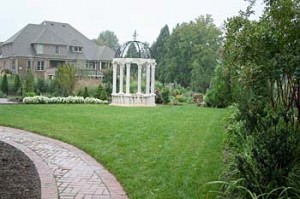 For centuries lawns of grass have been viewed as a beautiful part of the landscape but recent times have experienced and change of heart. Concerns for the environment have raised questions regarding a number of issues including excessive water use and pollution of ground water and streams. So, what is good about having a lawn, and what is bad?
For centuries lawns of grass have been viewed as a beautiful part of the landscape but recent times have experienced and change of heart. Concerns for the environment have raised questions regarding a number of issues including excessive water use and pollution of ground water and streams. So, what is good about having a lawn, and what is bad?
Here are some reasons why lawns are and have been valued:
 Beauty: A well tended lawn integrates the garden and house, provides an attractive setting for the house, and enhances the flowers, shrubs, and trees.
Beauty: A well tended lawn integrates the garden and house, provides an attractive setting for the house, and enhances the flowers, shrubs, and trees.
 Recreation: Grass is soft and resilient so makes a good play surface for games such as tennis and soccer as well as for kids play areas.
Recreation: Grass is soft and resilient so makes a good play surface for games such as tennis and soccer as well as for kids play areas.
 Erosion Control: The dense mat of roots formed by grass is good at absorbing rainwater and preventing erosion.
Erosion Control: The dense mat of roots formed by grass is good at absorbing rainwater and preventing erosion.
 Gas Exchange: Grass uses carbon dioxide from the air and releases oxygen.
Gas Exchange: Grass uses carbon dioxide from the air and releases oxygen.
 Air Conditioning: Grass cools the atmosphere by absorbing the sun’s heat.
Air Conditioning: Grass cools the atmosphere by absorbing the sun’s heat.
 Dust Buster: Lawns trap dust, pollen, and other airborne particles.
Dust Buster: Lawns trap dust, pollen, and other airborne particles.
 Ground Cover: An outdoor area can be left to dirt, planted, or covered with mulch rocks, paving, concrete, decks or other non living material. Grass is one of the best plants for a ground cover because of its tolerance to foot traffic, over all usefulness, and attractiveness.
Ground Cover: An outdoor area can be left to dirt, planted, or covered with mulch rocks, paving, concrete, decks or other non living material. Grass is one of the best plants for a ground cover because of its tolerance to foot traffic, over all usefulness, and attractiveness.
On the other hand, there are very good reasons not to have a lawn or at least to reduce its size.
 Need for Water: Lawn grasses generally need a lot of water. Some climates provide enough water at the need times of the year but most do not.
Need for Water: Lawn grasses generally need a lot of water. Some climates provide enough water at the need times of the year but most do not.
 Time: Planting, mowing, weeding, fertilizing, spraying are all necessary for a good looking healthy lawn and they take a considerable amount of time. If you don’t want to do it yourself, you have to pay someone to do it and that adds to the expense.
Time: Planting, mowing, weeding, fertilizing, spraying are all necessary for a good looking healthy lawn and they take a considerable amount of time. If you don’t want to do it yourself, you have to pay someone to do it and that adds to the expense.
 Expense: A manicured lawn is not cheap. It is expensive to both install and maintain even when you do a lot of the work yourself. A lawn is cheaper than many other ground covers but less expensive than decks and patios.
Expense: A manicured lawn is not cheap. It is expensive to both install and maintain even when you do a lot of the work yourself. A lawn is cheaper than many other ground covers but less expensive than decks and patios.
 Environmental Concerns: Pesticides can enter the water supply if not properly applied. Same is true for fertilizers, although most of the current problem with nitrogen and phosphate levels is due to agricultural run off. Grass actually holds on to nutrients well.
Environmental Concerns: Pesticides can enter the water supply if not properly applied. Same is true for fertilizers, although most of the current problem with nitrogen and phosphate levels is due to agricultural run off. Grass actually holds on to nutrients well.
When considering the pros and cons of a lawn climate, cost, time, and environmental impact are all important and should be considered in regard to other alternatives. In addition, the size of the lawn may be an important factor; a small lawn might satisfy all your criteria and be a good compromise.
